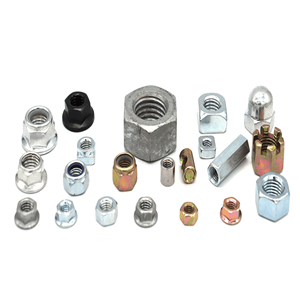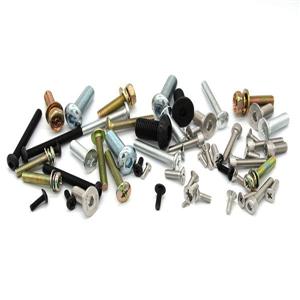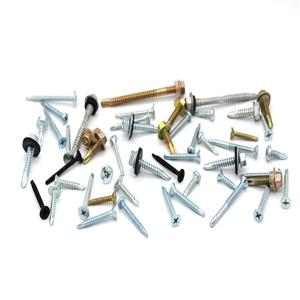Introduction of alloy steel for fastener products
Alloy steel has a history of more than 100 years. The industrial use of alloy steel was around the second half of the 19th century. There are thousands of alloy steel grades and tens of thousands of specifications used internationally. The output of alloy steel accounts for about 10% of the total steel output. It is an important metal material used in a large number of national economic construction and national defense construction.
Since the 1970s, the development of alloyed high-strength steels in the world has entered a new era. Based on controlled rolling technology and metallurgy of microalloying, modern low-alloyed high-strength steels, namely microalloyed steels, have been formed. new concept.
In the 1980s, the development of a variety involving a wide range of industrial fields and special materials, reached its peak with the help of metallurgical process technology. In the four-in-one relationship of chemical composition-process-structure-property of steel, for the first time, the dominance of microstructure and microstructure of steel has been highlighted for the first time. It also shows that the basic research of low-alloy steel has matured to an unprecedented level. New concept for alloy design.
Alloy element editing
Introduction
The main alloying elements of alloy steel are silicon, manganese, chromium, nickel, molybdenum, tungsten, vanadium, titanium, niobium, zirconium, cobalt, aluminum, copper, boron, and rare earth.
Among them, vanadium, titanium, niobium, zirconium, etc. are strong carbide-forming elements in steel. As long as there is sufficient carbon, under appropriate conditions, respective carbides can be formed. When carbon is lacking or under high temperature conditions, atomic State into solid solution; manganese, chromium, tungsten, molybdenum are carbide-forming elements, some of which enter the solid solution in an atomic state, and the other form a displacement alloy cementite; aluminum, copper, nickel, cobalt, silicon, etc. are not formed The carbide element generally exists in a solid solution in an atomic state.
effect
1. Carbon (C): Carbon content in steel increases, yield point and tensile strength increase, but plasticity and impact
Alloy structural steel
Alloy structural steel
The impact resistance decreases. When the carbon content exceeds 0.23%, the welding performance of the steel deteriorates. Therefore, the carbon content of the low alloy structural steel used for welding generally does not exceed 0.20%. High carbon content also reduces the steel's resistance to atmospheric corrosion, and high-carbon steel in open-air yards is susceptible to corrosion; in addition, carbon can increase the cold brittleness and age sensitivity of steel.
2. Silicon (Si): During the steel making process, silicon is added as a reducing agent and a deoxidizing agent, so the killed steel contains 0.15 to 0.30% silicon. If the silicon content in the steel exceeds 0.50-0.60%, silicon is considered an alloying element. Silicon can significantly improve the elastic limit, yield point and tensile strength of steel, so it is widely used as spring steel. Adding 1.0-1.2% silicon to the quenched and tempered structural steel can increase the strength by 15-20%. The combination of silicon and molybdenum, tungsten, chromium, etc. has the effect of improving corrosion resistance and oxidation resistance, and can manufacture heat-resistant steel. Low carbon steel containing 1-4% silicon, with extremely high magnetic permeability, is used to make silicon steel sheets in the electrical industry. Increasing the amount of silicon will reduce the welding performance of the steel.
3. Manganese (Mn): Manganese is a good deoxidizing agent and desulfurizing agent during steelmaking. Generally, manganese contains 0.30-0.50% of manganese. When adding more than 0.70% to carbon steel, even if it is "manganese steel", it will not only have sufficient toughness, but also have higher strength and hardness, improve the hardenability of steel, and improve the hot workability of steel. For example, 16Mn steel is 40% higher than A3 yield point. Steel containing 11-14% of manganese has extremely high wear resistance, and is used for excavator buckets, ball mill liners, etc. Increasing the amount of manganese reduces the corrosion resistance of steel and reduces the welding performance.
4. Phosphorus (P): In general, phosphorus is a harmful element in steel, which increases the cold brittleness of steel, deteriorates welding performance, reduces plasticity, and deteriorates cold bending performance. Therefore, the phosphorus content of steel is generally required to be less than 0.045%, and the requirements of high-quality steel are lower.
5. Sulfur (S): Sulfur is also a harmful element under normal circumstances. Makes the steel hot-brittle, reduces the ductility and toughness of the steel, and causes cracks during forging and rolling. Sulfur is also detrimental to welding performance and reduces corrosion resistance. Therefore, the sulfur content is usually required to be less than 0.055%, and the quality steel is required to be less than 0.040%. Adding 0.08-0.20% sulfur to the steel can improve the machinability, which is usually called free-cutting steel.
6. Chromium (Cr): In structural steel and tool steel, chromium can significantly improve strength, hardness and wear resistance, but at the same time reduce plasticity and toughness. Chromium can improve the oxidation resistance and corrosion resistance of steel, so it is an important alloy element for stainless steel and heat-resistant steel.
7. Nickel (Ni): Nickel can improve the strength of steel while maintaining good plasticity and toughness. Nickel has high corrosion resistance to acids and alkalis, and rust and heat resistance at high temperatures. However, since nickel is a scarce resource, other alloy elements should be used instead of nickel-chrome steel.
8. Molybdenum (Mo): Molybdenum can refine the grains of steel, improve hardenability and thermal strength, and maintain sufficient strength and creep resistance at high temperatures (stressed and deformed for a long time at high temperatures, said Creep). Adding molybdenum to structural steel can improve mechanical properties. It can also suppress the brittleness of alloy steel due to quenching. Redness can be improved in tool steel.
9. Titanium (Ti): Titanium is a strong deoxidizer in steel. It can make the steel's internal structure dense, refine the grain force; reduce aging sensitivity and cold brittleness. Improve welding performance. Adding appropriate titanium to chromium 18 nickel 9 austenitic stainless steel can avoid intergranular corrosion.
10. Vanadium (V): Vanadium is an excellent deoxidizer for steel. Adding 0.5% vanadium to the steel can refine the structure and grains and improve strength and toughness. The carbides formed by vanadium and carbon can improve the resistance to hydrogen corrosion under high temperature and pressure.
11. Tungsten (W): Tungsten has a high melting point and a high specific gravity. It is a noble alloying element. Tungsten and carbon form tungsten carbide with high hardness and wear resistance. Adding tungsten to tool steel can significantly improve the red hardness and heat strength, and is used as cutting tools and forging dies.
12. Niobium (Nb): Niobium can refine the grains and reduce the overheat sensitivity and temper brittleness of the steel, and improve the strength, but the plasticity and toughness have decreased. Adding niobium to ordinary low alloy steel can improve the resistance to atmospheric corrosion and hydrogen, nitrogen and ammonia corrosion resistance at high temperature. Niobium improves welding performance. Adding niobium to austenitic stainless steel can prevent intergranular corrosion.
13. Cobalt (Co): Cobalt is a rare and precious metal. It is mostly used in special steels and alloys, such as heat-resistant steel and magnetic materials.
14. Copper (Cu): Steel made by Wuhan Iron and Steel with Daye ore often contains copper. Copper can increase strength and toughness, especially atmospheric corrosion performance. The disadvantage is that hot brittleness is easy to occur during hot processing, and the plasticity is significantly reduced when the copper content exceeds 0.5%. When the copper content is less than 0.50%, it has no effect on weldability.
15. Aluminum (Al): Aluminum is a common deoxidizer in steel. Adding a small amount of aluminum to the steel can refine the grains and improve impact toughness, such as 08Al steel for deep drawing sheet. Aluminum also has oxidation resistance and corrosion resistance. The combination of aluminum with chromium and silicon can significantly improve the high temperature non-skin performance and high temperature corrosion resistance of steel. The disadvantage of aluminum is that it affects the hot workability, welding performance and cutting performance of steel.
16. Boron (B): Adding a small amount of boron to the steel can improve the compactness and hot rolling properties of the steel, and increase the strength.
17. Nitrogen (N): Nitrogen can improve the strength, low temperature toughness and weldability of steel, and increase aging sensitivity.
18. Rare earth (Xt): Rare earth elements refer to 15 lanthanides in the periodic table with an atomic number of 57-71. These elements are metals, but their oxides are much like "earth", so they are customarily called rare earths. Adding rare earth to the steel can change the composition, morphology, distribution, and properties of the inclusions in the steel, thereby improving various properties of the steel, such as toughness, weldability, and cold workability. Adding rare earth to plowshare steel can improve wear resistance.




